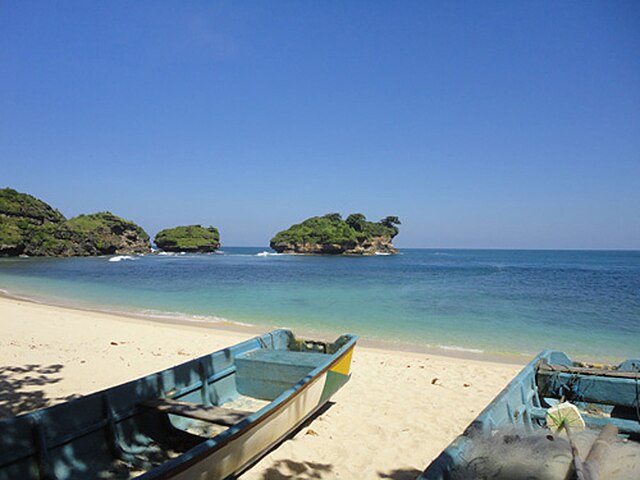Top Qs
Timeline
Chat
Perspective
Pacitan Regency
Regency in East Java, Indonesia From Wikipedia, the free encyclopedia
Remove ads
Pacitan Regency (Indonesian: Kabupaten Pacitan; Javanese: ꦏꦧꦸꦥꦠꦺꦤ꧀ꦥꦕꦶꦠꦤ꧀) is a regency located in the southwestern corner of East Java Province, with Central Java Province on its western border. Located between 7.55° - 8.17°S and 110.55° - 111.25°E. The borders of Pacitan Regency are with Wonogiri Regency (Central Java Province) in the west and north, Ponorogo Regency and Trenggalek Regency (both regencies of East Java) in the east, and the Indian Ocean in the south. It covers an area of 1,389.87 km2 and had a population of 540,881 at the 2010 census[2] and 586,110 at the 2020 census;[3] the official estimate as at mid 2024 was 588,718 (comprising 294,808 males and 293,910 females).[1] The capital of Pacitan Regency is the town of the same name. The majority of citizens in Pacitan speak Javanese as their first language, while speaking Indonesian as a second language.
Remove ads
Geography
Summarize
Perspective


Pacitan Regency covers an area about 1,389.90 km2. Approximately 88 percent of the regency consists of mountainous and rocky terrain, including several rocky canyons, as it lies within the Thousand Mountains region. The highest peaks in Pacitan Regency include Mount Lima in Kebonagung District and Mount Gembes in Bandar District, the latter forming the source of the Grindulu River.
Comparison of land types:
- Flat (0 - 5% slope) = 53.7 km2 (4%)
- Bumpy (6 - 10% slope) = 134.24 km2 (10%)
- Wavy (11 - 30% slope) = 322.18 km2 (24%)
- Hilly (31 - 50% slope) = 698.06 km2 (52%)
- Mountainous (more than 51% slope) = 134.24 km2 (10%)
Generally, the land in Pacitan can be divided into two categories, calcium-rich in the south, and fertile land in the north. The land consists of lithosol association, red mediterranean lithosol, tuff and volcanic compound, reddish lithosol complex, and grey alluvial, clay sediments containing many potential minerals. The minerals are feldspar, ball clay, bentonite, pyrophyllite, calcite, gypsum, phosphate rock, quartz, coal, dolomite, gemstone[clarification needed], tin ore, and manganite.
Pacitan Regency includes 130.87 km2 of rice fields and 1,211.55 km2 of dry land. According to irrigation types, the rice fields can be grouped into: technical irrigation rice field (16.06 km2), half technical irrigation rice field (11.88 km2), simple irrigation rice field (40.63 km2), and rain-dependent rice field (62.3 km2).
Remove ads
Administrative districts
Summarize
Perspective
Pacitan Regency is divided into twelve districts (kecamatan), tabulated below with their areas and population totals at the 2010 census[2] and the 2020 census,[3] together with the official estimates as at mid 2024.[1] The table also includes the locations of the district headquarters, the number of administrative villages in each district (totaling 166 rural desa and 5 urban kelurahan - the latter all in Pacitan (town) District), and its postal codes.
Note: (a) comprises 5 urban kelurahan (Baleharjo, Pacitan, Ploso, Pucangsewu and Sidoharjo) and 20 desa.
Remove ads
Beaches
Pacitan Regency has 17 beaches; to the west of Pacitan town are: Banyu Tibo, Buyutan, Karang Bolong, Srau, Klayar, and Watu Karung; near Pacitan town are: Pantai Teleng Ria, Tamperan Gung, Kali Uluh, and Wawaran; to the east of Pacitan town are: Pidakan, Soge, Tawang, Taman, and Kunir. All beaches are near to the 70 kilometers of South Coast Road from Wonogiri Regency to Trenggalek Regency. Soge Beach can be accessed in 30 minutes drive or by bus public transport from Pacitan town, but all beaches are relatively far from big cities such as Surabaya (7 hours) and Surakarta (4 hours),[16] but it is closer from Yogyakarta.
Pacitan town
Pacitan town forms an administrative district (kecamatan) in the centre of the regency, and constitutes an urban area on Pacitan Bay (Teluk Pacitan). It is composed of 5 urban villages (kelurahan) and 20 rural villages (desa), listed below with their populations as at mid 2023:[7]
|
|
|
|
|
Remove ads
Tourism
Summarize
Perspective
The verifiability of the claims made in this article is disputed. (September 2025) |
Pacitan, often referred to as the "City of Tourism" (Kota Pariwisata) or "City of a Thousand Caves" (Kota Seribu Goa), is noted for its ecological diversity and natural attractions.[citation needed] Tourist attractions in Pacitan include cave explorations, surfing, hiking, visits to historical places, and bathing in natural springs. A multi-purpose sports arena is under construction.
Several limestone caves are notable. Gua Gong (Gong Cave) is frequently cited as a major tourist attraction.[17] Gua Kalak (Kalak Cave) is traditionally believed to have been a meditation site of former president Soeharto,[citation needed] and Gua Tabuhan (Tabuhan Cave) is associated with Alibasyha Sentot Prawirodirjo.[citation needed] Gua Luweng Jaran (Luweng Jaran Cave) contains stalactites and stalagmites said to produce sounds resembling gamelan music.[citation needed]
Pacitan's coastline features a variety of beaches. Watu Karung Beach, Klayar Beach, Srau Beach, and Kasap Beach are known for white sand and coral formations. Teleng Ria Beach is located near the city center. Soge Beach is notable for a prominent bridge. Taman Beach hosts a turtle-conservation program, and Sidomulyo Beach offers Indonesia's longest zip line attraction.[citation needed] Banyu Tibo beach contains a small waterfall that flows directly into the sea. Other beaches are less documented.
Remove ads
Notable people
Pacitan is the birthplace of the former army general and the former (and first directly elected) president of Indonesia, Susilo Bambang Yudhoyono
References
See also
Wikiwand - on
Seamless Wikipedia browsing. On steroids.
Remove ads




